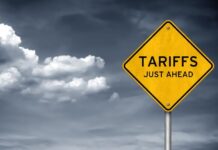U.S. President Donald Trump’s tariff decisions since he took office on Jan. 20 have shocked financial markets and sent a wave of uncertainty through the global economy.
With more tariffs announced this weekend, a timeline of some of the major developments follows:
- Feb. 1: Trump imposes 25% tariffs on Mexican and most Canadian imports and 10% on goods from China, demanding they curb the flow of fentanyl and illegal immigrants into the United States.
- Feb. 3: Trump suspends his threat of tariffs on Mexico and Canada, agreeing to a 30-day pause in return for concessions on border and crime enforcement. The U.S. does not reach such a deal with China.
- Feb. 10: Trump raises tariffs on steel and aluminum to a flat 25% “without exceptions or exemptions”
- March 3: Trump says 25% tariffs on goods from Mexico and Canada will take effect March 4.
- March 5: Trump agrees to delay tariffs for one month on some vehicles built in Canada and Mexico after a call with the CEOs of General Motors, Ford and the chair of Stellantis.
- March 6: Trump exempts goods from Canada and Mexico under a North American trade pact for a month from the 25% tariffs.
- April 2: Trump announces global tariffs with a baseline of 10% across all imports and significantly higher duties on some of the United States’ biggest trading partners.
- April 9: Trump pauses for 90 days most of his country-specific tariffs that kicked in less than 24 hours earlier following an upheaval in financial markets that erased trillions of dollars from stock markets around the world. He also says he will raise the tariff on Chinese imports to 125% from the 104% level that took effect a day earlier.
- April 13: The U.S. administration grants exclusions from steep tariffs on smartphones, computers and some other electronics imported largely from China.
- May 4: Trump imposes a 100% tariff on all movies produced outside the U.S.
- May 9: Trump and British Prime Minister Keir Starmer announce a limited bilateral trade agreement that leaves in place 10% tariffs on British exports, modestly expands agricultural access for both countries and lowers prohibitive U.S. duties on British car exports.
- May 12: The U.S. and China agree to temporarily slash reciprocal tariffs. Under the 90-day truce, the U.S. will cut the extra tariffs it imposed on Chinese imports to 30% from 145%, while China’s duties on U.S. imports will be slashed to 10% from 125%.
- May 23: Trump says he is recommending a straight 50% tariff on goods from the European Union starting on June 1.
- May 25: Trump backpedals on his threat to slap 50% tariffs on EU imports, agreeing to extend the deadline for talks until July 9.
- May 28: A U.S. trade court blocks Trump’s tariffs from going into effect in a sweeping ruling that the president overstepped his authority by imposing across-the-board duties on imports from U.S. trade partners. The administration says it will appeal the ruling.
- May 29: A federal appeals court temporarily reinstates the most sweeping of Trump’s tariffs, pausing the lower court’s ruling to consider the government’s appeal, and orders the plaintiffs in the cases to respond by June 5 and the administration by June 9.
- June 3: Trump signs an executive proclamation activating a hike in the tariffs on imported steel and aluminum to 50% from 25%.
- July 3: Trump says the U.S. will place a 20% tariff on many Vietnamese exports, with trans-shipments from third countries through Vietnam facing a 40% levy.
- July 7: Trump says on Truth Social the additional higher duties announced in earlier months will kick in with delay on August 1, as the U.S. closes on completion of several trade deals.
- July 10: Trump says the U.S. will impose a 35% tariff on imports from Canada next month and plans to impose blanket tariffs of 15% or 20% on most other trading partners.
- July 12: Trump threatens to impose a 30% tariff on imports from Mexico and the European Union starting on Aug. 1.
Earlier this year, the Exhibitions & Conferences Alliance (ECA) released a statement saying the coalition of leading professional and industry associations that advocates on behalf of the business and professional events industry opposes new tariffs—as they could raise prices on everything from cellphones to cellophane, including hiking the already inflated cost of some common meeting and event products such as electronics, staging materials and branded merchandise.
You May Also Be Interested In…
How Shifts in Federal Policies Are Affecting Business












